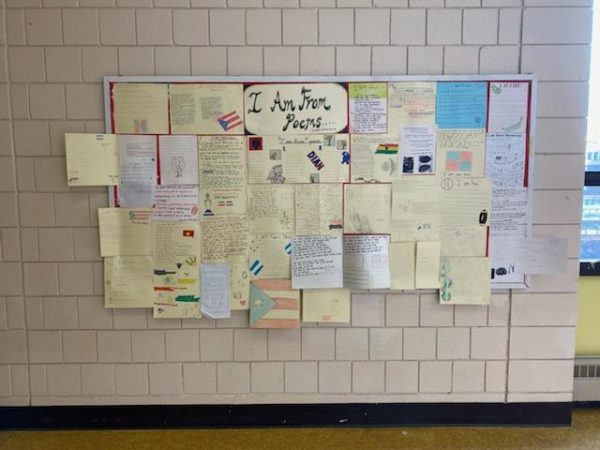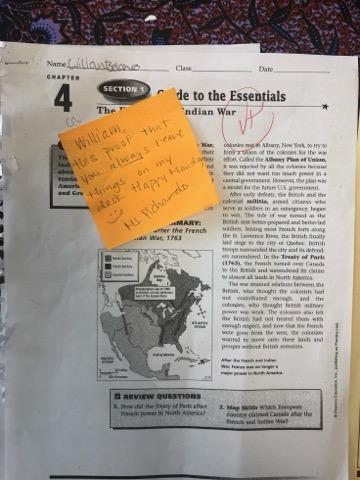 Oh, The Places You’ll Go!
Oh, The Places You’ll Go!
I wrote my first poem when I was in the fifth grade. For the first time ever I was asked to write about myself and what I valued most in life. I didn’t write another poem until my second year as an undergrad—in class, as my professor gave a lengthy lecture on Piri Thomas’ Down These Mean Streets. My experiences as a learner of the English discipline and as an ELL student in Massachusetts have heavily influenced my personal teaching philosophy. This year, my teaching philosophy has become more apparent and inherently political as the current policies of our country directly impact many of my students and their families. I believe that all students of English should have the opportunity become great readers and writers. They should be given the tools necessary to understand the importance of reading and writing and its power to create personal and social change in our world.
As a student teacher at South High Community School, I have been exposed to many of the challenges that my students face when they encounter reading and writing. My ELL students struggle greatly in part because of their language barrier, but also because their intelligence has been taken away from them— in many cases students have expressed the idea that not knowing English has become synonymous with having a lack of intelligence. Others struggle to make connections with and understand the text because they don’t have any choice in what they read or it is not made relevant to their own life experiences. Essentially, what I have noticed is that many students have learned to endure reading and writing rather than embracing it. My goal as an English teacher is to make students fall in love with reading and writing regardless of style and genre and find new ways to express themselves and their ideas.
I Am From…
Exploring our own identities and culture has been essential in my classroom this year. I believe that writing has the power to teach us about ourselves and our communities in ways that some of my students have found unbelievable. Students should be able to learn more about themselves and where they come from through reading and writing. This is my goal for all students, and being able to witness their progress and their process is what makes teaching so rewarding for me. Below is a wall dedicated to showcasing student’s “I Am From” poems.
Choice Matters
Giving students a choice in what they get to read has been very helpful in terms of making learning accessible to all students. This year, I designed different units centered around various novels in order to meet the skills, needs, and interests of students in the classroom. I have found that students want to have a choice, and giving them one truly encourages them to embrace reading rather than enduring it. Whenever I am not able to find books that directly relate to the lives of my students, I find supplementary materials for them to engage with or challenge them to make the text about themselves by reading from various literary lens.
Students should also be exposed to literature written by or about the communities and cultures they are a part of. When reading works written by or about people like them, students feel empowered, yet they are challenged to be more open about the ways in which they see themselves and others. When writing about themselves, students gain a an understanding of who they are and where they come from. All students in my classroom engage in a lot of narrative writing that challenges them to express their knowledge, ideas, and how they feel about things that affect their daily lives. When writing, students should also be given the opportunity to use and find value in their home language(s), this may be through the use of another language, dialect, or vernacular English. I believe that giving students a choice in what and how they learn is essential for powerful learning in and beyond the classroom.
CreatiVe-19
My creativity shows up in the texts I choose to read with students, my self-designed puzzles for reading comprehension, my interactive lessons, as well as my integration of meme and popular culture. Amidst concerns surrounding Covid-19, my placement at South High Community School was cut a few weeks short. During this time, students were still expected to learn from home and complete electronic assignments. Though I knew learning from home would be extremely difficult for many of my students, especially those who required supports for learning, I tried to keep them inspired to continue reading our books by re-creating a popular Tik Tok challenge. I reminded students that this was a hard time for all of us, but that I too was continuing to learn with and from them.
See my look-book inspired by our classroom reads below:
Collaboration & Community Building
Collaboration and community building lie at the center of every unit I designed this year. I find that allowing and encouraging students to collaborate and respect each other through community building fosters a positive learning environment. Whenever I assign my students to write, I ask them to think about the stories they wish they read in class, and the truths or secrets they wish they could share with the world. Students in my classroom are also encouraged to share the work they produce in and outside of the classroom. These goals to me are essential as I strive to help students realize that language and literature can help them gain new perspectives about themselves, the world around them, and most importantly give them the skills necessary to express themselves and make change in their communities. These are skills that not only foster a positive classroom environment, but that will prepare students to be successful in life no matter where they end up after high school.
Community building and collaboration also contributes to student’s respect for themselves and others. As students explore the literature of their choice, they expose themselves to world(s) and places beyond their own. This helps them build both empathy and respect as they become aware of the behaviors of people alike and different from them. Reading diverse literature is a very important philosophy for me because it also helps students navigate the world that they live in. As a student of English, I was rarely ever exposed to authors of color which made it difficult for me to find joy or interest in reading. I hope that through exposing my students to diverse literature they can gain a love for reading and begin to read for leisure.
Critical Thinking
Lastly, I believe all students of English should be able to think and read critically. I do not expect all of my students will take what I teach them or ask them to read as a fact, I instead encourage them to challenge some of my own views of the texts we engage with. As our world continues change rapidly, I believe that all students should be able to think and read critically in order to be successful. Furthermore, I hope that reading and learning through a critical lens helps students gain a passion for challenging and protecting everything that is important to them. Overall, I hope that my teaching philosophy helps students answer the following essential question:
How does reading and writing help us learn who we are and how can we use writing to empower ourselves and others?
Reflection on Identity as a Teacher
My teacher identity is motherly, attentive, snappy, creative and passionate. It is my goal to welcome students into my classroom everyday with a smile, even when the first thing I want to do is ask is if they did their homework. I believe that my creative lessons, immediate feedback and thoughtful interactions with students allow me to build great relationships while simultaneously maintaining high expectations. Having a great rapport with every student lies at the center of my work as a teacher because getting to know my students allows me to understand how they learn best. The proximity in age that my students and I share has been very helpful in building relationships and a positive classroom environment. I believe that often my students see me as a friend and mentor, yet my high expectations in the classroom ensure that we maintain professional boundaries. I took every chance I got to get to know my students, and give them a chance to get to know me.




















